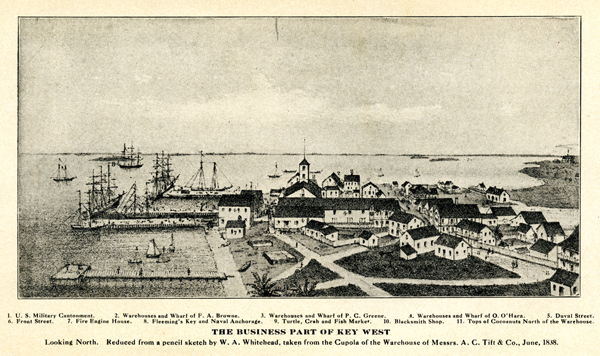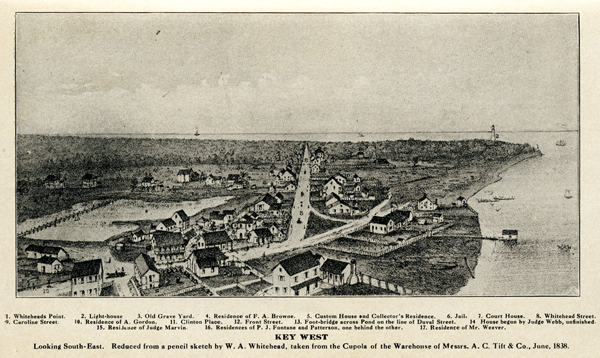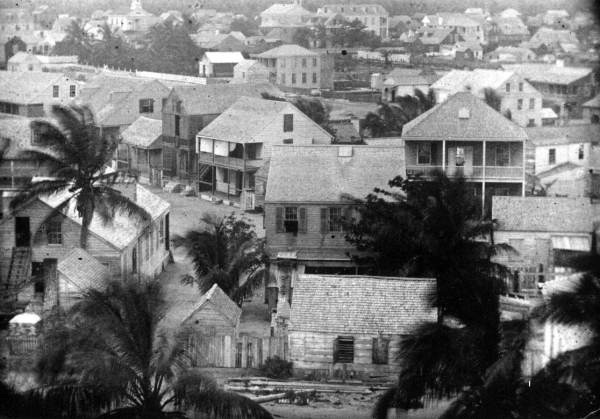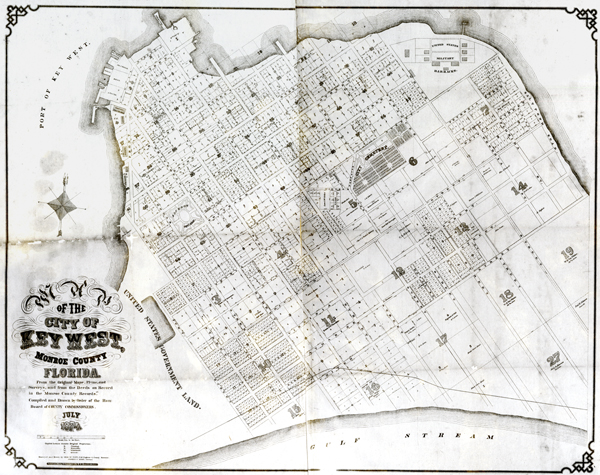Description of previous item
Description of next item
Early Views of Key West
Published December 12, 2013 by Florida Memory
It’s that time of year again…
As cool winter breezes penetrate deeper into the Florida peninsula with each passing cold front, mainlanders begin to yearn for something a little more tropical.
For a lucky few, Key West has become part of the winter routine. Those with the wherewithal to venture down to the southernmost city during the colder months may be unaware of the island’s early history, when Key West was plagued by everything from malaria to water shortages and fire to hurricanes.
The images below are some of the earliest renderings of the island known to the Americans as Key West, long before it became a tourist mecca in the days of Flagler and Hemingway.

Sketch of Key West by William A. Whitehead, ca. 1838, reproduced in Jefferson Browne, Key West: The Old and the New (St. Augustine: The Record Company, 1912)
These two sketches (above and below), drawn by William A. Whitehead, portray Key West as it appeared from the cupola atop A. C. Tift’s warehouse in the late 1830s. William and his brother John were prominent citizens in the small island community. William served as customs collector from 1830 to 1838. He left Key West in 1838, never to return, because the town council refused to institute an occupational tax he supported.

Sketch of Key West by William A. Whitehead, ca. 1838, reproduced in Jefferson Browne, Key West: The Old and the New (St. Augustine: The Record Company, 1912)
The image below is believed to be one of the oldest landscape daguerreotypes of Florida. It dates to about 1850 and was likely taken from an observation tower in the vicinity of Front and Simonton Streets. Visible near the horizon are First Baptist (left) and St. Paul’s Episcopal (middle) churches.
The steeple of St. Paul’s Episcopal Church helps date this item to circa 1850. St. Paul’s, built in 1839, was destroyed by a hurricane in 1846. It was rebuilt in 1848, but burned along with much of the city in the fire of 1886. In 1909 and 1910, the church again suffered damage from powerful tropical weather. The present Gothic Revival-style structure, constructed of steel and concrete, held its first services in 1914. According to an early historian of Key West, First Baptist Church on Eaton Street (upper left) was built in 1848.
The map below, created by the Monroe County Commissioners in 1874 from city property records, shows Key West as it appeared in the late 19th century. During the 1860s and 1870s, Key West hosted a large contingent of Cubans fleeing from the Ten Years War (1868-1878) in their homeland. This conflict served as a precursor to the Cuban War of Independence (1895-1898), during which Key West again played a vital role for the exile community.
Cuban businessmen in exile, including Vicente Martínez Ybor, transplanted their cigar rolling operations to Key West during the Ten Years War. Ybor later moved his factories to Tampa and started the community that now bears his name.
Cite This Article
Chicago Manual of Style
(17th Edition)Florida Memory. "Early Views of Key West." Floridiana, 2013. https://www.floridamemory.com/items/show/295141.
MLA
(9th Edition)Florida Memory. "Early Views of Key West." Floridiana, 2013, https://www.floridamemory.com/items/show/295141. Accessed December 5, 2025.
APA
(7th Edition)Florida Memory. (2013, December 12). Early Views of Key West. Floridiana. Retrieved from https://www.floridamemory.com/items/show/295141

 Listen: The Assorted Selections Program
Listen: The Assorted Selections Program
